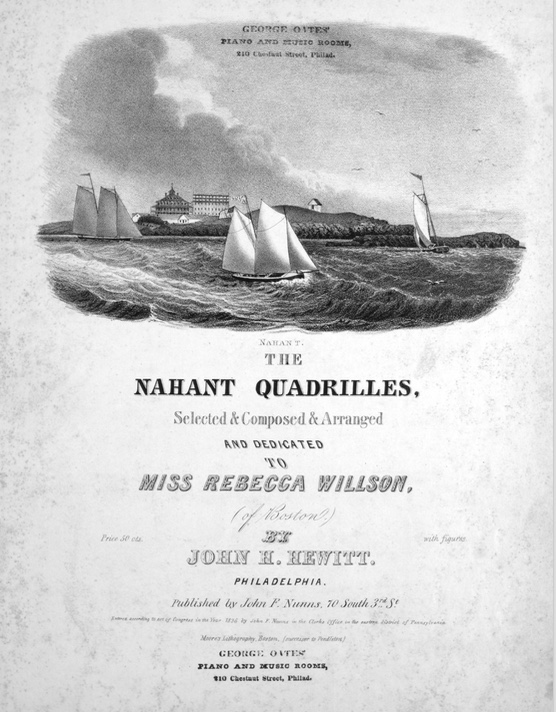 At left is the cover of The Nahant Quadrilles, published in Philadelphia in 1836 but named after the resort town of Nahant, located on a peninsula near Boston and seen in the background of the cover image (click to enlarge). For many years, Nahant has been the home of a summer 1860s ball hosted by Nahant resident and Vintage Victorian proprietor Katy Bishop and her late husband Ben. The Nahant Quadrilles were first worked on for these balls by the Bishops and my own late mentor, Patri Pugliese, in a style befitting the 1860s milieu in which they were used. Patri was a stickler in his approach to dance reconstruction and dubbed his version a “choreography” because of the degree of adaptation.
At left is the cover of The Nahant Quadrilles, published in Philadelphia in 1836 but named after the resort town of Nahant, located on a peninsula near Boston and seen in the background of the cover image (click to enlarge). For many years, Nahant has been the home of a summer 1860s ball hosted by Nahant resident and Vintage Victorian proprietor Katy Bishop and her late husband Ben. The Nahant Quadrilles were first worked on for these balls by the Bishops and my own late mentor, Patri Pugliese, in a style befitting the 1860s milieu in which they were used. Patri was a stickler in his approach to dance reconstruction and dubbed his version a “choreography” because of the degree of adaptation.
I’ve long had my own reconstruction of this set tucked away, and since the Nahant ball (lately expanded to a full weekend) is canceled due to Covid, this seems an opportune moment to publish it and compare the different approaches.
The original sheet music by John H[ill] Hewitt for The Nahant Quadrilles, with the dance calls, may be found online at the Lester S. Levy Sheet Music Collection of Johns Hopkins University. The five tunes were named after women, with the first, “Rebecca”, presumably for the cover dedicatee, Miss Rebecca Willson. It has been recorded by the dance band Spare Parts in a version matching Patri’s choreography on their album Dancing by the Shore, which may be purchased here. That is a bit problematic for my reconstruction, which I will discuss as I work through the figures.
Given the 1836 date, my approach to the reconstruction is to work in the style of the 1810s and 1820s and to perform the figures with French quadrille steps of the early nineteenth century. This series assumes a general familiarity with nineteenth century quadrilles and the standard figures of the French quadrille in the early nineteenth century, though in deference to American tradition I will generally use English terms for the figures except where originally published in French or clearer in that language. I will give quick recommendations for steps as I go along.
Figure One: “Rebecca” A=8b, B=8b; played A + BABAAx4 (8b + 40bx4)
The challenges start immediately: the music has only two eight bar strains and markings for a Da Capo pattern (ABA), which is inadequate for the forty-bar dance figure. I have no quarrel with the way Spare Parts structured the repeats for the recording, which works just fine for my reconstruction.
The original dance instructions:
Forward and back. 1st two cross over. Chassez across back to places. Balance and turn partners. Grand Right and Left. Repeat four times.
This is essentially an Été figure with a grand chain (grand right and left) tacked on, much in the style of a Finale figure. It’s rather odd for an opening figure; I’ll come back to that issue later. But I feel the reconstruction is straightforward:
8b Introduction (for honors; not repeated)
8b First pair forward/back, cross over
8b Chassez-dechassez, cross back
8b Balance and turn partners two hands
16b Grand chain
Repeat three more times for the other three pairs
The first pair is the first lady and opposite gentlemen, the second pair the second lady (opposite head lady) and opposite gentleman, the third pair the third lady (to the right of the first head couple) and opposite gentlemen, and the fourth pair the fourth lady and opposite gentleman. This is a standard quadrille progression.
Typically L’Été includes another chassez-dechassez before the first crossing over and merges the crossing back into the balance, but there were quite a few variations caused by the need to cram twenty-eight bars of figures into twenty-four bars of music. Leaving out the first chassez-dechassez was one approach to the problem.
I have previously covered possible sequences for forward and back, crossing over, chassez-dechassez, and balancing (setting). For the two-hand turn, three chassé; jeté, assemblé. For the grand chain, I favor the same three chassé; jeté, assemblé sequence four times (but have discussed other possibilities here). The dancers will “pause” briefly in their travel as they meet their opposite and their partner.
And what did Patri do with this figure? Recognizing the Été structure, he choreographed it in the way the second figure was danced in mid-nineteenth century America, as described in detail by Thomas Hillgrove in the description of the Quadrille in his A complete practical guide to the art of dancing (New York, 1863), beginning here, with the addition of a Grand Chain at the end. Patri’s entire figure may be seen here; in brief, rather than two opposite dancers the figure is danced by two opposite couples, meaning that it is exactly the same the first two and second two times (heads/heads and sides/sides). This was obviously a deliberate decision in adapting it into an 1860s-style quadrille.
Next up: figures two and three!


Leave a Reply